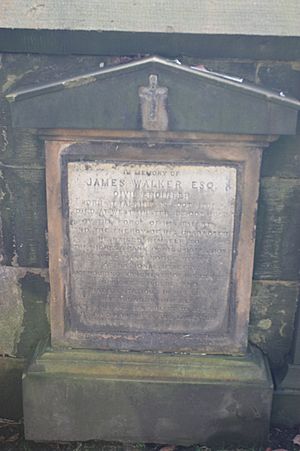James Walker (engineer) facts for kids
Quick facts for kids
James Walker
|
|
|---|---|

James Walker
|
|
| Born | 14 September 1781 Falkirk, Scotland
|
| Died | 8 October 1862 (aged 81) |
| Nationality | British |
| Citizenship | United Kingdom |
| Education | University of Glasgow |
| Occupation | Engineer |
| Engineering career | |
| Discipline | civil engineering |
| Institutions | Institution of Civil Engineers (president), Fellow of the Royal Society of Edinburgh, Fellow of the Royal Society of London |
| Practice name | Walker & Burges |

James Walker (born September 14, 1781 – died October 8, 1862) was a very important British engineer. He helped build many amazing things like docks, lighthouses, and even parts of the Houses of Parliament. He was known for his work in civil engineering, which involves designing and building structures like bridges, roads, and canals.
Contents
Early Life and Education
James Walker was born in Falkirk, Scotland, on September 14, 1781. He was the oldest of five children. He went to school in his hometown. When he was 13, in October 1794, he started studying at Glasgow University.
At university, he studied subjects like Latin, Greek, and logic. In his last two years, he focused on natural philosophy (which is like science) and mathematics. He was very good at these subjects and even won first prize.
Starting His Engineering Career
After finishing university in 1799, James thought about a career in business or law. But his life took a different turn. In 1800, he traveled to London with his brother-in-law. There, he visited his uncle, Ralph Walker, who was also an engineer.
His uncle Ralph was very impressed with James's understanding of engineering. He quickly offered James a job as his apprentice. This was the start of James Walker's long and successful career in engineering.
Building London's Docks and Roads
Around 1800, James and his uncle worked on designing and building the West India Docks and East India Docks in London. These docks were very important for ships bringing goods to the city.
When James was just 21, he took on his first big project by himself. He designed and built Commercial Road in London. This road connected the West India Docks to the busy warehouses in the City. Later, from about 1810 until he died, he also worked on the Surrey Commercial Docks.
Designing Lighthouses
In 1821, James Walker built his first lighthouse. This was the West Usk Lighthouse, located near Newport in South Wales. Lighthouses are tall towers with bright lights that help guide ships safely.
Over his career, James Walker designed and built 21 more lighthouses. His work helped make sea travel much safer for many years.
Leading Engineering Firms
James Walker became the main partner in an engineering company called Messrs. Walker and Burges. John Burges had started as James's student in 1811 and became a partner in 1829. Their offices moved to Parliament Street in Westminster, London.
Later, in 1853, James made one of his assistants, James Cooper, a partner. The company then became known as Messrs. Walker, Burges & Cooper.
President of Engineers
James Walker took over from his friend Thomas Telford as the President of the Institution of Civil Engineers. He held this important position from 1834 to 1845. This institution is a professional group for civil engineers.
One of his first big tasks as president was to help choose a new harbor for Edinburgh, Scotland. After looking at different options, they decided to build Granton Harbour.
He was also the chief engineer for Trinity House. This organization is responsible for lighthouses and navigation in England and Wales. His role here explains why he was so involved with coastal engineering and lighthouses.
Later Life and Legacy
James Walker passed away in London on October 8, 1862. He is buried in St Johns churchyard in Edinburgh.
His work had a lasting impact on engineering. He designed many important structures that are still in use or have influenced modern designs.
Notable Projects and Works
James Walker worked on a wide range of engineering projects. Here are some of his most famous contributions:
- Greenland Dock, London (from 1808 to 1862)
- Vauxhall Bridge, London (built in 1816, later taken down)
- West Usk Lighthouse, near Newport, South Wales (built in 1821)
- Survey for the Leeds and Selby Railway (1829)
- Brunswick Wharf Warehouse, Blackwall, London (designed 1832–34)
- Survey for the Leipzig–Dresden Railway (1835)
- Start Point lighthouse, Devon (1836)
- Maplin Sands Lighthouse (1838)
- Victoria Viaduct (or Bridge) on the Durham Junction Railway (1838)
- Improvements to Aberdeen Harbour (1838)
- South Bishop Lighthouse (1839)
- Wolf Rock beacon and lighthouse (1840–1862)
- Coquet Lighthouse (1841)
- Plans for River Thames embankments (around 1842). These plans were used for the Thames and Victoria Embankments.
- South Foreland Lighthouse rebuilt with a taller tower (1841-1842)
- Trevose Head Lighthouse (1844–1847)
- Gunfleet Lighthouse, off Frinton-on-Sea, Essex (1850)
- Design of the East Bute Dock, Cardiff (1855)
- Whitby Lighthouse - the twin lights of Whitby North and Whitby South lighthouses (1857–58)
- Bishop Rock lighthouse (1858)
- Needles Lighthouse, Isle of Wight (1859)
- Completion of the Caledonian Canal (1838–1848)
- Alderney breakwater, Channel Islands (1847) and harbor (1862)
- St Catherine's Harbour, Jersey, Channel Islands (1847–1856)
- Improvements to navigation in the River Tyne (1853–1861)
- Houses of Parliament, consulting engineer for the Clock Tower (Big Ben), Victoria Tower, and Central Tower (1836–1859). He also worked on the foundations for the riverside terrace.
Walker also helped design a dock harbor in Hamburg, Germany, in 1845. He was also a consulting engineer for the Board of Admiralty for a long time.
Memorial
A special memorial for James Walker was put up at Greenland Dock. The Institution of Civil Engineers asked for it to be built, and it was unveiled in 1990.


